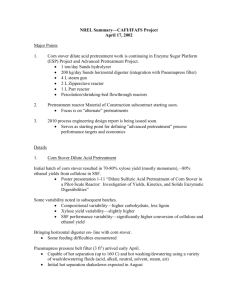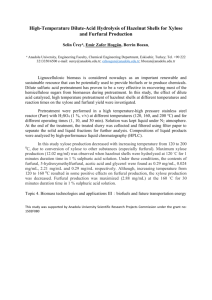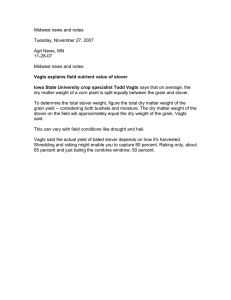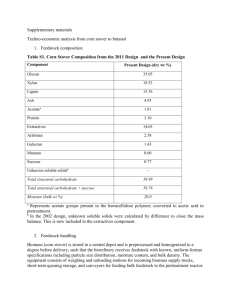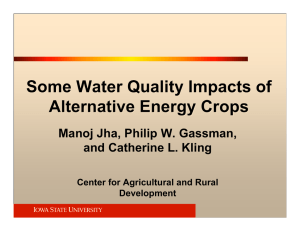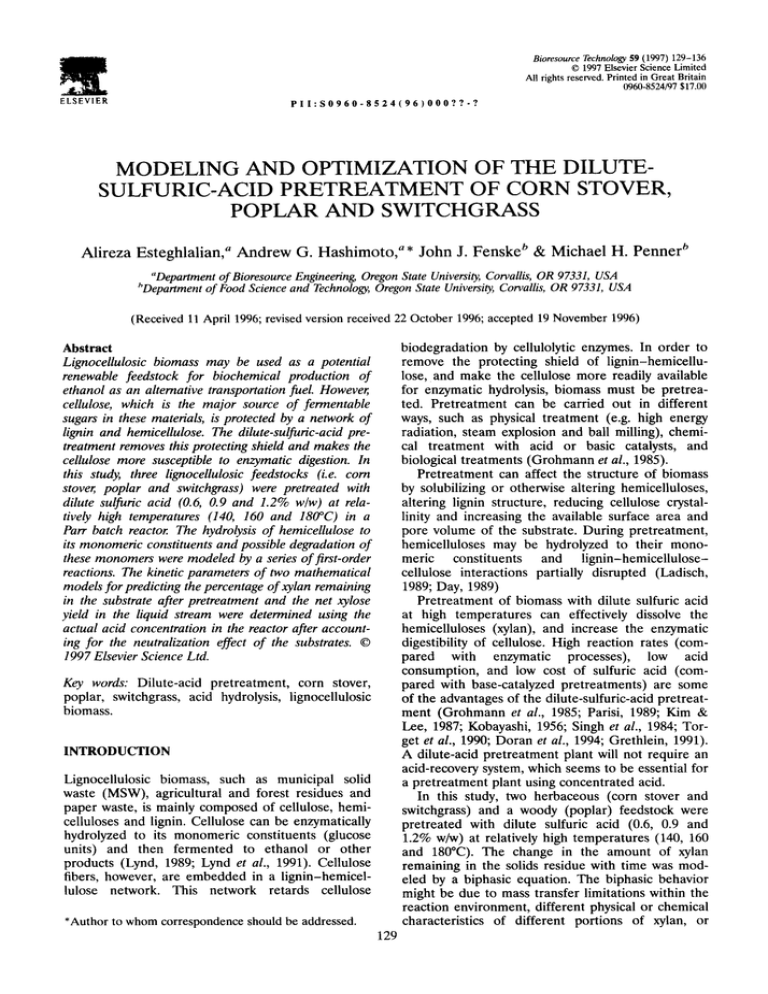
Bioresource Technology 59 (1997) 129-136
© 1997 Elsevier Science Limited
All rights reserved. Printed in Great Britain
0960-8524/97 $17.00
ELSEVIER
PII:S0960-8524(96)000??-?
MODELING A N D OPTIMIZATION OF THE DILUTESULFURIC-ACID PRETREATMENT OF CORN STOVER,
POPLAR A N D SWITCHGRASS
A l i r e z a E s t e g h l a l i a n , a A n d r e w G. H a s h i m o t o , a* J o h n J. F e n s k e b & M i c h a e l H. P e n n e r b
"Department of Bioresource Engineerin& Oregon State University, Corvallis, OR 97331, USA
hDepartment of Food Science and Technology, Oregon State University, Corvallis, OR 97331, USA
(Received 11 April 1996; revised version received 22 October 1996; accepted 19 November 1996)
biodegradation by cellulolytic enzymes. In order to
remove the protecting shield of lignin-hemicellulose, and make the cellulose more readily available
for enzymatic hydrolysis, biomass must be pretreated. Pretreatment can be carried out in different
ways, such as physical treatment (e.g. high energy
radiation, steam explosion and ball milling), chemical treatment with acid or basic catalysts, and
biological treatments (Grohmann et al., 1985).
Pretreatment can affect the structure of biomass
by solubilizing or otherwise altering hemicelluloses,
altering lignin structure, reducing cellulose crystallinity and increasing the available surface area and
pore volume of the substrate. During pretreatment,
hemicelluloses may be hydrolyzed to their monomeric constituents and lignin-hemicellulosecellulose interactions partially disrupted (Ladisch,
1989; Day, 1989)
Pretreatment of biomass with dilute sulfuric acid
at high temperatures can effectively dissolve the
hemicelluloses (xylan), and increase the enzymatic
digestibility of cellulose. High reaction rates (compared with enzymatic processes), low acid
consumption, and low cost of sulfuric acid (compared with base-catalyzed pretreatments) are some
of the advantages of the dilute-sulfuric-acid pretreatment (Grohmann et al., 1985; Parisi, 1989; Kim &
Lee, 1987; Kobayashi, 1956; Singh et al., 1984; Torget et al., 1990; Doran et al., 1994; Grethlein, 1991).
A dilute-acid pretreatment plant will not require an
acid-recovery system, which seems to be essential for
a pretreatment plant using concentrated acid.
In this study, two herbaceous (corn stover and
switchgrass) and a woody (poplar) feedstock were
pretreated with dilute sulfuric acid (0.6, 0.9 and
1.2% w/w) at relatively high temperatures (140, 160
and 180°C). The change in the amount of xylan
remaining in the solids residue with time was modeled by a biphasic equation. The biphasic behavior
might be due to mass transfer limitations within the
reaction environment, different physical or chemical
characteristics of different portions of xylan, or
Abstract
Lignocellulosic biomass may be used as a potential
renewable feedstock for biochemical production of
ethanol as an alternative transportation fuel. However,
cellulose, which is the major source of fermentable
sugars in these materials, is protected by a network of
lignin and hemicellulose. The dilute-sulfuric-acid pretreatment removes this protecting shield and makes the
cellulose more susceptible to enzymatic digestion. In
this study, three lignocellulosic feedstocks (i.e. corn
stover, poplar and switchgrass) were pretreated with
dilute sulfuric acid (0.6, 0.9 and 1.2% w/w) at relatively high temperatures (140, 160 and 180°C) in a
Parr batch reactor. The hydrolysis of hemicellulose to
its monomeric constituents and possible degradation of
these monomers were modeled by a series of first-order
reactions. The kinetic parameters of two mathematical
models for predicting the percentage of xylan remaining
in the substrate after pretreatment and the net xylose
yield in the liquid stream were determined using the
actual acid concentration in the reactor after accounting for the neutralization effect of the substrates. ©
1997 Elsevier Science Ltd.
Key words: Dilute-acid pretreatment, corn stover,
poplar, switchgrass, acid hydrolysis, lignocellulosic
biomass.
INTRODUCTION
Lignocellulosic biomass, such as municipal solid
waste (MSW), agricultural and forest residues and
paper waste, is mainly composed of cellulose, hemicelluloses and lignin. Cellulose can be enzymatically
hydrolyzed to its monomeric constituents (glucose
units) and then fermented to ethanol or other
products (Lynd, 1989; Lynd et al., 1991). Cellulose
fibers, however, are embedded in a lignin-hemicellulose network. This network retards cellulose
*Author to whom correspondence should be addressed.
129
130
A. Esteghlalian, A. G. Hashimoto, J. 1 Fenske, M. 1t. Penner
structural changes of xylan during hydrolysis (Conner, 1984; Maloney et al., 1985). The rate constants
of xylan hydrolysis and xylose degradation reactions
were assumed to have an Arrhenius-type temperature dependency.
METHODS
Biomass feedstocks
Herbaceous (corn stover and switchgrass) and
woody (hybrid poplar) feedstocks were provided by
the National Renewable Energy Laboratory
(NREL).
Pretreatment
All pretreatment experiments were carried out in a
Parr reactor model #4563. This 600 ml stainlesssteel reactor was equipped with a glass liner, a heat
exchanger and an impeller-type mixer. Figure 1
shows a schematic diagram of the reactor. The solid
concentration in the reaction mixture was 10%
(w/w). Aqueous solution of 30.00 g of substrate in
the required amount of distilled water was heated to
the desired temperature (140, 160, or 180°C), and
reaction was initiated by the injection of preheated
acid (0.6, 0.9, or 1.2% w/w). The acid injection pressure exceeded the internal reactor pressure by
15 psi. Time zero for all reactions corresponded with
acid injection. The reactor temperature was controlled by a Parr controller model #4831. A solenoid
valve adjusted the water flow through the internal
heat exchanger, and regulated the temperature at
+I°C. Each reaction was terminated by running
cold water through the internal heat exchanger,
while simultaneously removing the heating mantle
and spraying the external surface of the reactor with
cold water. The chosen method allowed constant
stirring while cooling, thereby maintaining a relatively homogeneous environment. This method
provided a 20°C temperature decrease within less
than 30 s and, therefore, a three-fold decrease in the
reaction rate. As a result, reaction was effectively
terminated after 30 s. The pretreated materials were
then filtered (Whatman No. 5) and washed with distilled water ( - 1500 ml). The total volume of the
liquid stream (both filtrate and wash) was recorded,
and a 125 ml sample was stored at 4°C until analyzed. The solids residue was dried in an oven at
45°C for 24 h.
Analytical methods
The neutral monosaccharide composition of the
constituent polysaccharide in the initial feedstocks
was quantified by an HPLC-based assay of the
hydrolysate resulting from a two-stage sulfuric acid
To Nitrogen Gas
/
Cooling we
IN
from solen~
id Injection
finder; wrapped
th Heating Tape
Nay Valve
tst acid
tion
Heat
Exchanger
:ouple
Fig. 1. Stainless-steel reactor (Parr model 4563) with acid-injection system, mixer and cooling coil.
131
Dilute-sulphuric-acid pretreatment of feedstocks
solution to the neutralizing ability (gHzSO4]g dry
substrate) of a feedstock:
treatment. Sugars were separated using a Bio-rad
Aminex HPX-87P column and quantified based on
the signal from a Waters 401 refractive index
detector using Waters Baseline 810 integration software. The neutral monosaccharide composition of
hydrolysates from pretreated residues and the
neutral sugar composition of the soluble phase
resulting from pretreatments were also determined
by this method. Lignin plus other acid-insoluble
components were determined as Klason lignin.
Moisture and ash contents were determined by
standard methods as described in NREL Alternative
Fuels Division Chemical Analysis and Testing
Standard Procedure No. 005 (Ehrman, 1992). Acetic
acid and furfural concentrations of pretreatment filtrates were determined on a Varian 1400 gas
chromatograph equipped with a flame-ionization
detector.
Since the basic cations of lignocellulosics can partially neutralize the sulfuric acid (Grohmann et al.,
1985; Malester et al., 1992; Springer & Harris, 1985),
the acidity of the reaction mixture is lowered by the
neutralizing capacity of the substrate. The neutralizing ability (NA) of each feedstock was determined
by measuring the pH of sulfuric acid (0.6, 0.9 and
1.2%)/distilled water solutions before (pHDw) and
after (pHs) mixing with the feedstock. The proportions of substrate, acid and water were the same as
in the pretreatment experiments. The following eqn
(1) was used to correlate the change of pH of acid
NA = MWH2so4 x [10 -pHDW- 10-vHs]/
solid concentration
(1)
The solid concentration in the reactor is
expressed as g dry substrate/l liquid (acid+water).
KINETIC M O D E L D E V E L O P M E N T
Results of dilute-acid pretreatment of lignocellulosic
feedstocks (hardwoods, softwoods, grasses and
wastepaper) indicate that the amount of xylose
remaining in biomass changes in a biphasic fashion
with time (Grohmann et al., 1985; Kim & Lee, 1987;
Kobayashi, 1956; Maloney et al., 1985; 1986; Nee &
Wen, 1976; Conner, 1984). It is assumed that there
are two types of xylan in biomass, i.e. fast- and slowreacting, and the overall hemicellulose hydrolysis
reaction is presented as
HemicelluloseFFast.reactingxylan
(xylan)
Xylose
(in liquid)
LSlow-reacting xylan
k,
>
k~ >
~2 > Degradation byproducts
Table 1. Compositional analysis of raw biomass samples (percent by weight)
Component
Switchgrass
Total glycans
glucan
xylan
galactan
arabinan
mannan
Klason lignin
Acid-soluble lignin
Ash
Uronic acid
Other
Poplar
Corn stover
Mean
SEM"
Mean
SEM"
Mean
SEM ~
56.6
32.2
20.3
.
3.7
0.4
19.5
3.7
7.1
1.1
12.0
0.29
0.26
58.2
39.8
14.8
0.01
0.03
1.2
2.4
26.9
2.2
1.3
2.4
9.0
0.02
0.04
0.26
0.06
0.02
0.13
-
59.9
36.0
19.8
1.3
2.8
17.8
1.9
7.2
ndb
13.2
0.4
0.25
0.05
0.06
0.08
0.03
0.01
-
.
.
0.04
0.02
0.3
0.03
0.06
0.01
-
.
~Standard error of the mean.
bNot determined.
Table 2. Kinetic parameters of the biphasic model: X = ,Yr.e-ka +Xs. e - ~ t for switchgrass, polar and corn stover
Xf ~..... ge):
kf:
Xs~..... ge):
ks:
Ao
E (kJ/mol)
n
Ao
E (kJ/mol)
n
Switchgrass
Poplar
Corn stover
76.8%
1.9 × 10zl
169.0
0.4
23.2%
4.2 x 1023
201.7
2.0
83.8%
3.3 x 1021
176.7
0.4
16.2%
3.3 X 1022
192.0
1.5
64.4%
6.7 X 1016
129.8
1.5
35.6%
6.9 x 1019
167.6
1.6
132
A. Esteghlalian, A. G. Hashimoto, J. J. Fenske, M. H. Penner
All three reactions (kf, ks, kz) are assumed to be
of first order:
X R = X f + X s = Xfo. e-/q .t
+Xso.e -k~''
d [xylan]fast/dt = - kf.[xylan]fast
(2)
d[xylan]sJow/dt = -ks.[xylan]s~ow
(3)
d[xylose]/dt=kf.[xylan]fast +ks.[xylan]slow
-kz.[xylose]in liquid
(4)
d[byproducts]/dt = kz.[xylose]i, liquid
(5)
By integrating eqns (2) and (3):
Xf = Xfo. e -k,..t
(6)
Xs =Xso.e -k~''
(7)
The total amount of xylan remaining in the solids
residue can be obtained by adding these two portions, i.e. Xf and Xs:
Table 3. Percentage of fast-reacting xylan (Xfo) in different
types of iignocellulosic feedstocks
Reference
Feedstock
Conner (1984)
Southern red oak
Paper birch
Red maple
Quacking aspen
American elm
Aspen
Wheat straw
Paper birch
Southern red oak
Corn stover
Switchgrass
Poplar
Grohmannetal. (1985)
Maloney et al. (1985)
Kim & Lee (1987)
This study
where XR: percentage of total xylose equivalents
remaining in the solids residue relative to the initial
weight of xylose in the substrate; Xf, As: percentage
of fast- and slow-reacting xylan at any time; Xfo, Xso:
percentage of fast- and slow-reacting xylan at t = 0;
X~o = 100-Xfo; kf and ks: rate constants of fast- and
slow-reacting xylan hydrolysis (rain-1); t: time (rain).
The reaction rate constants (kf, ks, k2) are
assumed to have an Arrhenius-type temperature
dependence (Maloney et ai., 1985; Ranganathan et
al., 1985; Nee & Wen, 1976):
k =A
.e -E/R'T
A: pre-exponential factor; E: activation energy (kJ/
mol); R: 8.3143 x 10 -3 (kJ/mol.K). The pre-exponential factor, A, is assumed to be dependent upon
acid concentration (Ca):
Xfo
A = Ao. C'~
(%)
73.9
71.6
80.3
76.0
84.3
76.0
67.0
68.4
69.7
64.4
76.8
83.8
(8)
therefore
k = Ao. C~. e - e r a r
(9)
The actual acid concentration, Ca, can be calculated from the nominal acid concentration (C)
using eqn (10), in which the coefficient 0.1 represents the solid ratio in the reactor (g dry
substrate/g total mass of reaction mixture) for all
pretreatments:
Ca = C - ( 0 . 1 x neutralizing ability of the substrate)
Table 4. Kinetic parameters of xylan hydrolysis rate constant: K = Ao C n. e--E/R/"
Reference
Grohmann et al. (1985)
Kim & Lee (1987)
Maloney et al. (1985)
This study
Feedstock
Wheat straw
kf
ks
Aspen wood
kf
ks
Southern red oak
kf
ks
Paper birch
kf
ks
Switchgrass
kf
ks
Poplar
kf
ks
Corn stover
kf
ks
aNot determined.
Parameter
Ao
n
E
(kJ/mol)
nda
nd
nd
nd
50.2
104.6
nd
nd
nd
nd
117.2
154.8
1.04 x 1014
6.00 × 1012
1.54
1.19
120.1
118.0
2.67 × 1016
16 × 1019
1
1
126.6
156.5
1.9 x 1021
0.4
169.0
4.2 x 1023
3.3 x 1021
3.3 x 1022
2.0
0.4
1.5
210.7
176.7
192.0
6.7 x 1016
6.9 x 1019
1.5
1.6
129.8
167.6
Dilute-sulphuric-acidpretreatmentof feedstocks
133
Table 5. Parameters of xylose degradation rate constant:
K2-A
r.= e-E~/Rr in acid hydrolysis of switchgrass,
poplar and corn stover
Ao2
E2 (kJ/mol)
n2
Switchgrass
3.8 × 10 I°
99.5
1.45
Poplar
8.5 x 101°
102.0
0.55
Corn stover
3.7 × 101°
98.4
0.50
!
.o
(10)
The neutralizing abilities ( g H 2 S O J g d u substrate) of the three feedstocks are reported in the
Results and Discussion section.
At each set of reaction conditions (temperature
and acid concentration), pretreatments were carried
out at different reaction times. After each pretreatment, the amounts of xylose remaining in the solids
residue (XR), and in the liquid stream were measured. There was no indication of xylan hydrolysis at
elevated temperatures (140, 160 and 180 °C) during
the preheat time prior to initiating the reaction with
acid. The kinetic parameters of the biphasic model
[eqn (8)] were calculated by non-linear regression
analyses (Microsoft Excel) on eqn (8) using measured values of XR and corresponding times (t).
Thus, nine kf, k~ and Xfo values were calculated (one
per each set of T and C). There was no apparent
relationship between the percentage of fast-reacting
xylan (Xfo) and pretreatment conditions. Therefore,
the average value of Xfo was used to calculate XR.
The calculated values of kf and ks were used to
determine the kinetic parameters (Ao, n and E) of
10
o
• l!i"i0i:i:ii
i ii
]
0
I
I
I
I
0.5
1
1.5
2
I ~
2.5
3
t-
I
I
I
3.5
4
4.5
5
time (rain)
Fig. 3. Xylan hydrolysis of switchgrass.
each reaction rate constant (kf and ks) using linear
regression analyses (Microsoft Excel) on a transformed Arrhenius equation:
In(k) = ln(Ao)+n .In(Ca)-E/RT
(11)
100
100
.4
10
10
I e 160 C, 0.6% acid
• 180 C, 0.6% acid
a 180 C, 0.9*/, acid
o
• 140 C, 0.6% acid
• 140 C, 1.2% acid
•
10
20
30
180 C, 0.6% acid
40
50
time (rain)
Fig. 2. Xylan hydrolysis of corn stover.
60
1+
0
0.5
1
1.5
2
2.5
3
3.5
time (rain)
Fig. 4. Xylan hydrolysis of poplar.
4
4.5
5
134
A. Esteghlalian, A. G. Hashimoto, J. J. Fenske, M. H. Penner
In order to determine the maximum amount of
XL at a given set of temperature and acid concentration:
90-
dXL/dt = 0
(16)
Applying this condition to eqn (14) gives
[(ks.Xeo)/(k2- ks)J/I(ks .Xso)/(k2 - kf)]
180
= [(kJk2). e (k:-k")',..... 1]/[1 - (kf/k2). e (k2-k')'tm"~]
'0
(17)
~ture (*C)
I.I
Add Concentration
(w~, %)
1.2
Fig. 5. Percentage of sugar (xylose) recovery from pretreatment of switchgrass.
Net xyiose yield in liquid prehydrolysate
The xylose monomers, produced from xylan hydrolysis, may be converted to other byproducts, such as
furfural. Although oligomers of xylose have been
reported using other reactor configurations, in a
batch mode under the conditions of time, temperature and acid concentration employed in this study
no oligomers were observed. The net amount of
xylose in the liquid stream (XL) is determined by the
following differential equation accounting for both
formation and possible degradation of xylose:
where tm~ is the reaction time (rain) at which the
net sugar yield in the liquid phase (at given temperature and acid concentration) is maximum. At a given
set of temperature and acid concentration, the lefthand side of eqn (17) is a constant (Kr, c), and the
equation has a unique solution (tm~,) which may be
determined by iteration. The following equation
derived from eqns (13) and (16) gives the maximum
sugar yield (XL) in the liquid phase:
XL @t,,,,~= (kf.Xfo/k2). e -k,.tm.~
+ (ks .Xsdk2). e~-k'tm"x
(18)
Finally, the amount of xylose converted to
byproducts (L) is determined by combining eqns (8)
and (14):
L = 100- [XR+XL] = 100
-Xeo[(k,. e -k2., _ k2. e -k"t)/(k,.-- kz) ]
(12)
d X L / d t = k f . X f + k s .Xs - k2 .XL
-Xso[(ks. e -k~.,-k2. e - k " t ) / ( k s -k2)]
Using eqns (8) and (12):
(19)
dXL/dt+k2.XL = kf.Xfo.e-k"t +ks.Xso.esk.t
(13)
By solving eqn (13), XL can be expressed as
XL = [(ke.Xfo)/(k2
-ks)].
[e -k,.t _
e -k~'t I
+ [(ks.Xso)/(k2-ks)]. [e-k~'t-e-k~q
(14)
where XL: net sugar yield-percentage of xylose in
liquid (relative to initial weight of xylose in starting
material); Xfo: percentage of fast-reacting xylose at
t = 0; )(so: percentage of slow-reacting xylose at
t = 0; X~o = 100-Xfo; t: time (min); kf and ks: rate
constants of fast- and slow-reacting xylan hydrolysis
(rain-1); k2: xylose conversion rate constant (min-~)
given by
k2 --- Ao2. Ca
n: . e - - E 2 / R T
where L: percentage of xylose loss by degradation
reaction (relative to initial weight of xylose in starting material); XL: percentage of xylose in liquid
(relative to initial weight of xylose in starting
material).
(15)
where R = 8.3143 x 10 -3 kJ/mol.K; T: temperature
(K); Ca: actual acid concentration (wt%); see eqn
(10). The best estimates of k2 [eqn (14)] at each
set of reaction conditions (T and C) were determined by using the best estimates of ke, ks and Xfo
[see eqn (8)] and XL values measured analytically.
These values (kz) were then used to calculate the
kinetic constants of eqn (15) by non-linear regression analysis (Microsoft Excel).
RESULTS AND DISCUSSION
The chemical composition of the three feedstocks,
corn stover, poplar and switchgrass, is shown in
Table 1. The major components of these substrates
were glucan, lignin and xylan. Corn stover and
switchgrass (herbaceous substrates) had higher ash
contents than poplar.
The neutralizing abilities of corn stover, switchgrass and poplar were determined as 43.7, 25.8 and
16.7 mg H2SOJg dry substrate, respectively. The
higher neutralizing ability of corn stover and switchgrass was in agreement with their higher ash
content. Poplar had a considerably higher neutralizing ability (16.7mg H2SOJg dry wood) than other
hardwoods, e.g. paper birch (3.5 mg HESO4/g dry
wood) and red oak (8-9 mg HESO4/g dry wood)
reported by Maloney et al. (1985). This difference
can be attributed to the relatively high ash content
(1.3%) of poplar used in this study. Lower ash con-
Dilute-sulphuric-acid pretreatment of feedstocks
90-
so
180
F0
70
tpefature
¢c)
u..
1
1.1
1.2
Acid Concentration
(w/w %)
Fig. 6. Percentage of sugar (xylose) recovery from pretreatment of poplar.
tents have been reported for poplar and other
hardwoods: 0.7 and 0.6% for two types of poplar
(Torget et al., 1990); 0.8% for aspen wood; 0.4% for
sweetgum (Grohmann et al., 1985); and 0.3% for red
oak wood (Conner, 1984).
The kinetic parameters of the biphasic model
Ieqn (8)} and reaction rate constants (kf, ks) are
presented in Table 2. The percentage of fast-reacting xylan (Xfo) is the average of values determined
at different reaction conditions. Table 3 shows that
Xf values of corn stover, switchgrass and poplar
determined in this study are comparable to those
reported for other lignocellulosic substrates. The
woody feedstock (poplar) had a higher percentage
of fast-reacting xylan (X~o) than herbaceous substrates (switchgrass and corn stover). Such a
difference between woody (aspen) and herbaceous
(wheat straw) feedstocks was also reported by Grohmann et al. (1985) (see Table 3).
The activation energy of fast-reacting xylan in
poplar was found to be higher than those of switchgrass and corn stover. This can be attributed to the
difference in chemical composition of hemicelluloses
in woody and herbaceous materials. Hardwood
hemicelluloses are mainly composed of 4-O-methyl-
901180.0-90.0
I -="°°*°°1
60 0-70 0
L~_.
~ 80
o
.I
7o
180
~0
6(
temperature (*C)
D.u
1,1
1.2
Acid Concerltration
(wlw %)
Fig. 7. Percentage of sugar (xylose) recovery from pretreatment of corn stover.
135
glucuronoxylan, whereas in herbaceous materials
arabinoxylans are the principal hemicelluloses
(Grohmann et al., 1985; Sjostrom, 1993). Table 4
summarizes some of the kinetic parameters of acid
pretreatment of other feedstocks. These data are
comparable with those found in this study. A direct
comparison, however, cannot be made because of
the difference in reaction conditions.
The kinetic parameters of xylose degradation rate
constant (k2) are presented in Table 5. The rate of
xylose conversion is thought to be substrate independent. The results of this study also indicate some
similarities between the degradation rates of xylose
resulting from the three feedstocks. Activation
energies are essentially equal and preexponential
factors (Ao) and acid-dependency exponents (n) are
very close. However, k2 values calculated by using
these constants are slightly different. This discrepancy might be due to the difference in products of
xylan hydrolysis from different feedstocks and their
consequent effect on degradation of xylose. However, this cannot be verified at this level of
resolution.
Figures 2-4 show the experimental and modelpredicted values of xylose remaining in the solids
residue (XR) for corn stover, switchgrass and poplar,
respectively. The results indicate that by using concentrated sulfuric acid ( - 0 . 9 % )
at higher
temperatures ( - 180°C) about 90% of the xylan
could be dissolved within the first minute of the
reaction period.
The maximum net sugar yields resulting from pretreatment of switchgrass, poplar and corn stover at
different reaction conditions with optimum reaction
time [XL at tmax, eqn (18)] are shown in Figs 5, 6 and
7, respectively. An interesting fact revealed by Figs 5
and 6 is that temperature (not the acid concentration) is the major factor affecting the extent of sugar
recovery from pretreatment of poplar and switchgrass. It is only at high temperatures (e.g. 180°C)
that increasing the acid concentration can affect the
sugar recovery. In comparison, the xylose yield from
corn stover is more sensitive to a change in acid
concentration level, especially at higher temperatures. Likewise, the effect of temperature is more
pronounced at higher levels of acid concentration.
Figures 5-7 also indicate that pretreatment of the
feedstocks at harsher conditions produces higher net
sugar yields. At temperatures between 170-180°C
and with acid concentrations greater than 0.9%,
sugar yields from poplar and switchgrass are reasonably high (80%). The reaction times for obtaining
the maximum sugar yield under these conditions are
between 0.5 and 1 min. In case of corn stover, however, an 80% sugar recovery requires higher acid
concentrations (1.0%) at the same temperature
range (170-180°C). The net sugar yield from corn
stover is lower compared to those resulting from
poplar and switchgrass using similar reaction condi-
136
A. Esteghlalian, A. G. Hashirnoto, J. J. Fenske, M. H. Penner
tions. This might be in part due to the higher
neutralizing ability of corn stover, which substantially lowers the acid concentration in the reaction
mixture.
ACKNOWLEDGEMENTS
We would like to acknowledge the technical assistance of Jeffrey A. McKinnis, Ming-Che Wang,
Ean-Tun Alex Liaw and the technical staff of the
National Renewable Energy Laboratory. We
especially appreciate the comments and suggestions
of Dr Daniel Hsu of the NREL. This project was
funded by the National Renewable Energy Laboratory, project No. XR-2-11186-1.
REFERENCES
Conner, A. H. (1984). Kinetic modeling of hardwood prehydrolysis. Part I: xylan removal by water prehydrolysis.
Wood Fiber Sci., 16(2), 268-277.
Day, D. L. (1989). Biomass waste. Biomass Handbook, ed.
Osamu Kitani & Carl W. Hall. Gordon and Breech,
New York, pp. 142-147.
Doran, J. B., Aldrich, H. C. & Ingram, L. O. (1994).
Saccharification and fermentation of sugar cane bagasse
by Klebsiella oxytoca P2 containing chromosomally integrated genes encoding the Zymomonas mobilis ethanol
pathway. Biotechnol. Bioengng, 44, 240-247.
Ehrman, T. (1992). Determination of total solids/moisture
in biomass. NREL Alternative Fuels Division Chemical
Analysis and Testing Standard Procedure, No. 005.
Grethlein, H. E. & Converse, A. O. (1991). Common
aspects of acid prehydrolysis and steam explosion for
pretreating wood. Biores. Technol., 36, 77-82.
Grohmann, K., Torget, R. & Himmel, M. (1985). Optimization of dilute-acid pretreatment of biomass.
Biotechnol. Bioengng Symp., 15, 59-80.
Kim, S. B. & Lee, Y. Y. (1987). Kinetics in acid-catalyzed
hydrolysis of hardwood hemicellulose. Biotechnol. Bioengng Syrup., 17, 71-84.
Kobayashi, T. & Sakai, Y. (1956). Hydrolysis rate of pentosan of hardwood in dilute sulfuric acid. Bull. Agric.
Chem. Soc. Japan, 20(1), 1-7.
Ladisch, M. R. (1989). Hydrolysis. Biomass Handbook, ed.
Osamu Kitani & Carl W. Hall. Gordon and Breach,
New York, pp. 434-451.
Lynd, L. R. (1989). Production of ethanol from lignocellulosic materials using thermophilic bacteria: critical
evaluation of potential and review. Adv. Biochem.
Engng/Biotechnol., 38, 1-52.
Lynd, L. R., Cushman, J. H., Nichols, R. J. & Wyman, C.
E. (1991). Fuel ethanol from cellulosic biomass. Science,
251, 1318-1323.
Malester, I. A., Green, M. & Shelef, G. (1992). Kinetics
of dilute-acid hydrolysis of cellulose originating from
municipal solid wastes. Ind. Engng Chem. Res., 31,
1998-2003.
Maloney, M. T., Chapman, T. W. & Baker, A. J. (1985).
Dilute-acid hydrolysis of paper birch: kinetics studies of
xylan and acetyl group hydrolysis. Biotechnol. Bioengng,
27, 355-361.
Maloney, M. T., Chapman, T. W. & Baker, A. J. (1986).
An engineering analysis of the production of xylose by
dilute-acid hydrolysis of hardwood hemicelluloses. Biotechnol. Progress, 20(4), 192-202.
Nee, C. I. & Wen, F. Y. (1976). Hydrolysis of pentosans
in bagasse pith. J. Appl. Chem. Biotechnol., 26, 283-287.
Parisi, F. (1989). Advances in lignocellulosics hydrolysis
and in the utilization of the hydrolyzates. Adv. Biochem.
Engng/Biotechnol., 38, 53-87.
Ranganathan, S., Macdonald, D. G. & Bakhshi, N. N.
(1985). Kinetic studies of wheat straw hydrolysis using
sulfuric acid. Can. J. Chem. Engng, 63, 840-844.
Singh, A., Das, K. & Durlubh, K. S. (1984). Production of
xylose, furfural, fermentable sugars, and ethanol from
agricultural residues. Chem. Technol. Biotechnol., 34,
51-61.
Sjostrom, E. (1993) Wood Chemistry: Fundamentals and
Applications. Academic Press, London.
Springer, E. L. & Harris, J. F. (1985). Procedures for
determining the neutralizing capacity of wood during
hydrolysis with mineral acid solutions. Ind. Engng Chem.
Prod. Res. Dev., 24, 485-489.
Torget, R., Werdene, P., Himmel, M. & Grohmann, K.
(1990). Dilute-acid pretreatment of short rotation
woody and herbaceous crops. Appl. Biochem. Biotechnol., 24/25, 115-126.

